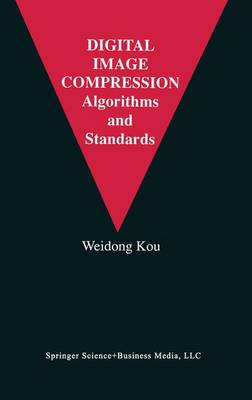The Springer International Series in Engineering and Computer Science
2 primary works
Book 333
Digital image business applications are expanding rapidly, driven by recent advances in the technology and breakthroughs in the price and performance of hardware and firmware. This ever increasing need for the storage and transmission of images has in turn driven the technology of image compression: image data rate reduction to save storage space and reduce transmission rate requirements. Digital image compression offers a solution to a variety of imaging applications that require a vast amount of data to represent the images, such as document imaging management systems, facsimile transmission, image archiving, remote sensing, medical imaging, entertainment, HDTV, broadcasting, education and video teleconferencing.
Digital Image Compression: Algorithms and Standards introduces the reader to compression algorithms, including the CCITT facsimile standards T.4 and T.6, JBIG, CCITT H.261 and MPEG standards. The book provides comprehensive explanations of the principles and concepts of the algorithms, helping the readers' understanding and allowing them to use the standards in business, product development and R&D.
Audience: A valuable reference for the graduate student, researcher and engineer. May also be used as a text for a course on the subject.
Digital Image Compression: Algorithms and Standards introduces the reader to compression algorithms, including the CCITT facsimile standards T.4 and T.6, JBIG, CCITT H.261 and MPEG standards. The book provides comprehensive explanations of the principles and concepts of the algorithms, helping the readers' understanding and allowing them to use the standards in business, product development and R&D.
Audience: A valuable reference for the graduate student, researcher and engineer. May also be used as a text for a course on the subject.
Book 394
Security is the science and technology of secure communications and resource protection from security violation such as unauthorized access and modification. Putting proper security in place gives us many advantages. It lets us exchange confidential information and keep it confidential. We can be sure that a piece of information received has not been changed. Nobody can deny sending or receiving a piece of information. We can control which piece of information can be accessed, and by whom. We can know when a piece of information was accessed, and by whom. Networks and databases are guarded against unauthorized access. We have seen the rapid development of the Internet and also increasing security requirements in information networks, databases, systems, and other information resources. This comprehensive book responds to increasing security needs in the marketplace, and covers networking security and standards. There are three types of readers who are interested in security: non-technical readers, general technical readers who do not implement security, and technical readers who actually implement security. This book serves all three by providing a comprehensive explanation of fundamental issues of networking security, concept and principle of security standards, and a description of some emerging security technologies. The approach is to answer the following questions: 1. What are common security problems and how can we address them? 2. What are the algorithms, standards, and technologies that can solve common security problems? 3.

